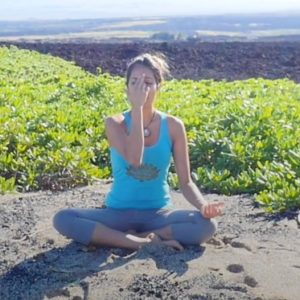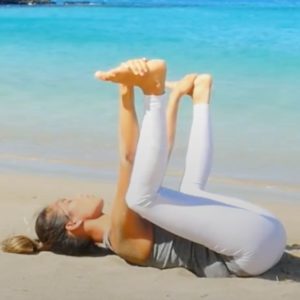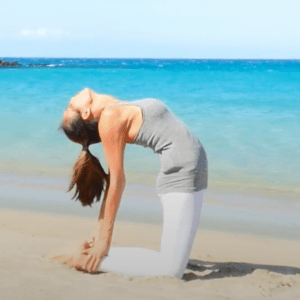Two poses for today are Child’s Pose and Fish Pose
Child’s Pose and Fish Pose
Child’s Pose and Fish Pose reduce stress and fatigue and stretch the shoulders and spine. Try these poses with Guided Yoga from YouVeda.
Child’s Pose – Balasana
Balasana is the Sanskrit word for Child’s Pose. Although it is a very simple posture, its effects are profound. The gentle forward-folding motion allows one to tap into deep states of relaxation, as it triggers the rest-and-digest mode of our parasympathetic nervous system. This is why Child’s Pose is often used to open a Yoga class, as a resting posture, or to wind down at the end of a sequence. By allowing us to let go of our egoic identifications, Balasana allows us to connect to our inner child, or Heart center: the part of us that is trusting, pure, and authentic.
Steps
- Sit in Vajrasana: Kneel on the ground with bent legs.
Keep the knees close to each other. Form a bowl with the soles of the feet, by bringing the heels beside the buttocks, while still sitting on them. - Straighten the spine, lift the chest, and slowly bend forward with a straight and elongated spine. Relax downward until the forehead touches the ground. The arms are placed in front of the body with bent elbows and forearms resting on the ground. Alternatively, the hands may be placed alongside the legs with palms facing upward.
- Activate the core muscles, inhale, and slowly lift the torso out of the pose.
Benefits
- Gently stretches the hips, thighs, and ankles.
- Tones the pelvic muscles and the sciatic nerves.
- Releases pressure from the spinal discs.
- Regulates the functioning of the adrenal glands.
- Activates Anahata Chakra, the Heart Chakra.
- Calms the brain and helps relieve stress and fatigue.
- It helps to eliminate anger and is very cooling for the brain.
- Soothes the personality, aids in overcoming the egoic identification.
- Getting in touch with the essence of our being – awakens the soul.
Fish Pose – Matsyasana
The fish pose, if carried out in the water, allows the body to float quite easily like that of a fish; hence the name.
Steps
- Lie on your back. Your feet are together and hands relaxed alongside the body.
- Place the hands underneath the hips, palms facing down. Bring the elbows closer toward each other.
- Breathing in, lift the head and chest up.
- Keeping the chest elevated, lower the head backward, and touch the top of the head to the floor.
- With the head lightly touching the floor, press the elbows firmly into the ground, placing the weight on the elbow and not on the head. Lift your chest up from in-between the shoulder blades. Press the thighs and legs to the floor.
- Hold the pose for as long as you comfortably can, taking gentle long breaths in and out. Relax in the posture with every exhalation.
- Now lift the head up, lowering the chest and head to the floor. Bring the hands back along the sides of the body. Relax.
Benefits of the Fish Pose
- Stretches the chest and neck
- Helps relieve tension in the neck and shoulders
- Provides relief from respiratory disorders by encouraging deep breathing
- Tones the parathyroid, pituitary and pineal glands




